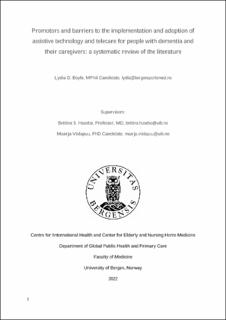| dc.description.abstract | Background One of the most pressing issues in our society is the provision of proper care and treatment for the growing global health challenge of ageing. Assistive Technology and Telecare (ATT) is a key component in facilitation of safer, longer, and independent living for persons with Dementia (PwD) and has the potential to extend valuable care and support for caregivers (formal and informal) globally. Results of this systematic review are of key importance because well-executed ATT implementation, leading to habitual usage and adoption, can assist and strengthen current healthcare services, improve access to healthcare and decrease societal and caregiver burden. Objective The objective of this study is to identify promotors and barriers to implementation and adoption of ATT for PwD and their informal (family and friends) and formal (healthcare professionals) caregivers. In addition, we aim to provide valuable insight for municipalities and healthcare organizations for improved implementation strategies. Methods The study was registered in PROSPERO 25th of February, 2021: CRD42021239448. NVivo was utilized for synthesis and analysis of article content. As the results were from diverse disciplines using varied methods of analysis, a semi-systematic approach with narrative synthesis was used for the review. PICO criteria and Preferred Reporting Items for Systematic Reviews and Meta-Analyses (PRISMA) guidelines have been used to guide all processes and results. Rayyan and NVivo were utilized for selection of articles and analysis of found themes. In addition, the Critical Appraisal Skills Programme (CASP) has been used to visualize meta-synthesis and meta-analysis results and overall quality of included literature. Results This review encompasses relevant information regarding the implementation and adoption of ATT for PwD and their caregivers from five continents and sixty-five countries. It is a true global representation of the growing challenge of ageing. In total, 32 publications were included for review. Identified primary promotors for the implementation and adoption of ATT were as follows: personalized (tailored) training and co-designed solutions, safety for the PwD, involvement of all relevant stakeholders (multi-faceted approach including PwD), ease of use and support (design and follow up), and cultural relevance. Main barriers for the implementation and adoption of ATT included: unintended adverse consequences, timing and disease progress, technology anxiety, system failures (connectivity, errors, etc.), digital divide and lack of access to or knowledge of available ATT. Conclusions The most crucial elements for the adoption of ATT in the future will be a focus on co-design, improved involvement of both the PwD and their caregivers, and the adaptability (tailoring related to context) of ATT solutions over time (disease process). 94% of the literature presented in the review comes from high income countries. There is a significant need for more quality research to be conducted in the regions of the world where population growth and prevalence of dementia is expected to grow most rapidly over the next 30 years. | |
